"Stalin's holiday": Operation "Uranus". H. 2
20 November
South-Western Front. At dawn of 20 in November, the 26 tank corps of Major General Tank Forces A.G. Rodin reached Perelazovsky, a large settlement, road junction. The 157-I tank brigade under the command of Lieutenant Colonel A. Shevtsova attacked the northern outskirts of Perelazovsky, and the 14-I motorized rifle brigade hit the enemy’s flank. As a result of a decisive strike, Perelazovsky was captured, and the headquarters of the Romanian 5 Army Corps located there was defeated. General A. G. Rodin describes this battle in the following way: “Without a single shot, we surrounded the village, and only when the tanks went on the attack under the cover of our artillery fire, did the enemy open their fire. But it was late, the tanks had already rushed into the streets. Less than an hour later, the fate of this important point was decided. Captured mass of prisoners, all staff documentation, communications center, printing house, warehouses, a hospital with the wounded, and even a bakery with bread, the mass of cars and other military equipment. "
The 26 tank corps also occupied the settlements of Novo-Tsaritsyn. Varlamovsky and to the 16 watch with a fight entered Efremovsky. The 19 Tank Brigade, operating on the left flank of the corps, together with the 119 Rifle Division, reflected the counterattack of the Romanian 1 Tank Division from the Zhirkovsky region. Part of the 4-th tank corps under the command of A. G. Kravchenko on this day went to the area of Mayorovsky. Having defeated the opposing units of the 1 of the Romanian and 14 of the German Tank Divisions, the 26 of the 4 of the Tank Corps advanced in the direction of Kalach.
The 1 tank corps, commanded by Major General V. V. Butkov, fought stubborn battles with the German 22 Panzer Division in the Peschanoye area. The 47-I Guards Rifle Division that came here, the 55 Cavalry Division of the 8 Cavalry Corps and the 8 Motorcycle Regiment also attacked the enemy. In the afternoon of November 20, the enemy was forced to withdraw, leaving Sandy. Commander Romanenko set the task for Butkov to quickly advance the 1 tank corps in a southwesterly direction, bypassing the fortified nodes of the enemy defense. Their liquidation was entrusted to the rifle divisions and the 8 Cavalry Corps of Major General M. D. Borisov. But it was not immediately possible to break through to the rear of the enemy, and during the night of November 21 and the whole of the next day the tankers fought with the entrenched enemy.
The 3 Guards cavalcade of General Pliyev, acting as part of the troops of the 21 Army, attacked Evlampievsky - a large enemy defense unit, where there was an airfield. Pliev's fighters repelled a strong counter-attack of the enemy and occupied the airfield, where 18 planes and other trophies were captured. K 14 hour. The cavalry corps reached the height of 208,8 - Platonov, where it met with strong resistance from the Romanian 7, 13 and 15 infantry divisions, reinforced by German 14 tank tanks, defending at the Tsimlovsky line - Platonov.
Thus, during November 20, tank corps of the Southwestern Front did not have much progress (two days 35-40 km), but decisive actions reflected the enemy’s operational reserves, some of which were defeated, including the 48 tank corps. Meanwhile, cavalry, infantry and artillery of the first echelon moved behind the tank corps, consolidating the progress achieved. Shooting units of the 5 tank and 21 armies from the west and east made a round of the flanks of the two Romanian corps, with the aim of surrounding them in the area of Raspopinskaya. The left-flank formations of the 21 Army of the South-Western Front and the troops of the 65 Army of the Don Front, developing an offensive in the south-east direction, went to the left flank of the German Army 6. The troops were delayed by the deadlines, but the common task was solved successfully.
Stalingrad front. November 20 launched an offensive on the Stalingrad Front. In accordance with the plan, its strike groups inflicted two blows: on the right flank by the forces of the 64 Army M.S. Shumilov and the 57 Army F.I. Tolbukhin and on the left flank - by the 51 Army N.I. Trufanov . Due to heavy fog, the artillery preparation was postponed for two hours, it began in 10 hours. The first hit "Katyusha", they began the work of artillery and mortars. Then the infantry went on the attack with the support of tanks. Thus, in the breakthrough areas of the 51 Army, the actions of the 126 and 302 infantry divisions were supported by two tank regiments of the 4 mechanized corps — the 158 and 55. Hiding behind smoke and dust from exploding shells and mines, Soviet tanks and infantry overwhelmed enemy defenses in the front line.
The 57 Army through the forces of the 422 and 169 rifle divisions broke through the enemy defenses on the front between Sarpa and Tsats lakes, striking south and south-west. Having completed the immediate task, the troops of the 57 Army turned in the direction of the collective farm. March 8 and further to the north-west, covering the enemy's Stalingrad grouping from the south-west. The 64 Army was launched by the formations of its left flank — the 36 Guards, 204 and 38 rifle divisions. Having broken through the enemy defenses on the front south of Elkhi, the troops of this army advanced to 4-5 km by the end of the day, having cleared the enemy from. Andreyevka. The main forces of the 51 Army were advancing from the Tsatsa inter-area, Barmantsak in the general direction towards Prolific, Verkhne-Tsaritsynsky, Sovetsky. Supporting the actions of the main forces from the north, the 15-I Guards Rifle Division of the 51 Army attacked the enemy from the Sarpa inter-area, Tsats, in the direction of the Privolzhsky state farm.
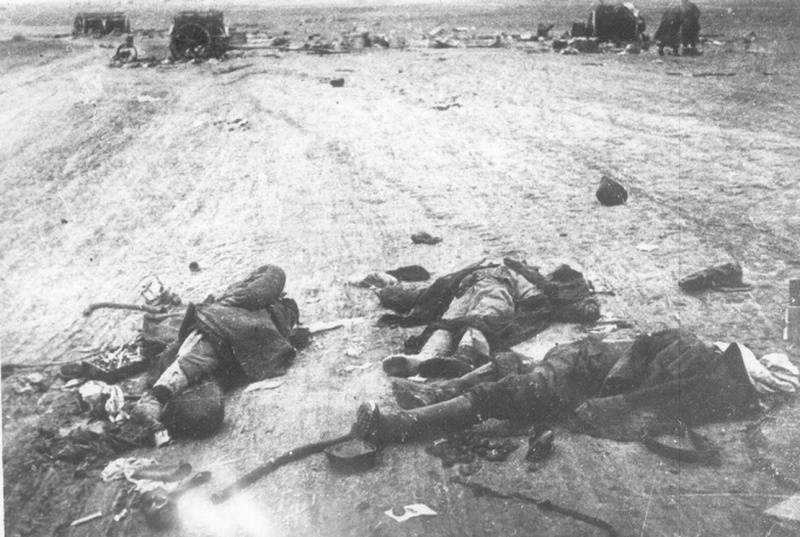
Killed soldiers of the 4 of the Romanian army near Lake Barmatsak, Stalingrad region
In the afternoon, when the shock groups of the Stalingrad Front broke through the enemy defenses in all three areas of the offensive, mobile formations were introduced into the breaches: 13 tank and 4 mechanized corps under the command of Colonel T.I. Tanaschishin and Major General V. T. Volsky and the 4 Cavalry Corps under the command of Lieutenant General T. T. Shapkin. The mobile troops of the front rushed into the depths of the enemy defenses in the north-west and south-west.
The 13 Tank Corps of the 57 Army was introduced into the 16 hours by two echelons and moved in two columns in the general direction of Nariman. By the end of the day, he covered the distance in 10-15 km. The pace of advance was lower than planned (30-40 km). There was a shortage of vehicles, and the motorized infantry moved on foot. The enemy attempted to counterattack by advancing against the advancing units the German 29 th motorized division from the reserve of Army Group "B". The 4 th mechanized corps of the 51 th army was introduced into a single echelon breakthrough in 13 hours, the 4 th corps corps entered the breakthrough 22 hours after the 4 th mechanized corps, developing an offensive in the western direction. Under the blows of the advancing Soviet forces, the 6 th Romanian corps operating here with heavy losses retreated to the Aksai area. The 7 th Romanian corps, which defended to the south in the Malye Derbety district, was with a bare flank.
Thus, the shock groups of the Stalingrad Front broke through the defenses of the German 4-th tank army and the 4-th Romanian army, and mobile units of the Soviet armies rushed into the resulting gap. The transition to the offensive of the Stalingrad Front made a depressing impression on the enemy. If the blow from the north of the command of the 6 Army was to some extent expected, then the blow in the south was completely unexpected for him. At the front at Stalingrad there was a radical change.
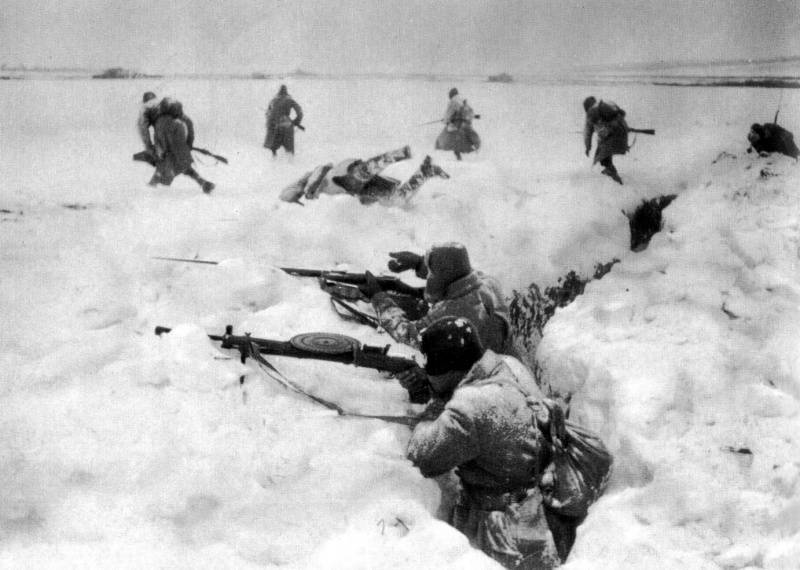
A detachment of soldiers Sergeant N. Surkov went on the attack in the area of Stalingrad. Photo source: http://waralbum.ru/
Enemy
19 November The 21-I army broke through the right flank of the 3-th Romanian army west of the Kletskaya, defeating the 4-th Romanian corps, and advanced to Selivanova. 5-I tank army, breaking through the position of the 2-th Romanian corps, in the evening reached its forward troops Gusynka and Kalmykov, going to the rear of the 3-th Romanian army. As a result, the main forces of the 3 of the Romanian army were bypassed and shot down from their positions. The 3 of the Romanian army did not have any reserves, and the weak reserves of the left flank of the 6 army could not change anything during such a large-scale offensive and breakthrough. Army Group Reserve - The 48 Tank Corps (22 Tank Division and 1 Romanian Tank Division), on which great hopes were pinned, counterattacked, but was defeated.
As the German General G. Dörr (“Hike to Stalingrad”) noted, the offensive of the Soviet troops was taken aback by the German command: “The 6 army in that day did not feel an immediate threat, and therefore its command did not consider it necessary to take decisive measures. At 18 hours, the army command reported that it plans to continue the actions of the intelligence units at Stalingrad on November 20. ” It was only late in the evening that the German command realized that a deadly threat was looming over the 6 army. On November 20, when the Soviet offensive began in the area south of Stalingrad, it became obvious to the Germans that the Russian command had conceived a large-scale operation to reach all German forces in the area of Stalingrad. Realizing the threat of encirclement, the command of the German 6 th army hastily began to transfer its reserves to the inside of the closed circle of encirclement of the Soviet troops. But it was too late. The development of events was ahead and made useless the attempts of the German command to counteract the Soviet offensive. It was proposed to withdraw the troops of the 6 Army to the southwest. However, Paulus did not dare to act contrary to the orders of Hitler.
The command post of 6 of the German army was threatened by the advancing Soviet forces, and Paulus ordered him to be transferred from Golubinsky to Lower Chirskaya. The command of the 6 Army shifted the 11 Corps so that it turned its front to the west and tried with the help of the 14 German Tank Corps quickly deployed here (parts of the 14, 16 and 24) tank divisions rear from the south. But this did not correct the situation.
Part of the enemy grouping panicked. Helmut Welz, the commander of the sapper battalion of the 79 of the German Infantry Division, writes: “On the phone, on the radio, from mouth to mouth, dreadful news of the terrible danger looming over the 6 army. For its headquarters, units, and 19 connections, November is a stunning day, a day of confusion. Events take such a turn, what no one expected, and require immediate countermeasures. Nervousness threatens to go into a panic. For many, paralyzing their will and energy, a vision of the horseman of the Apocalypse arises before his eyes. ”
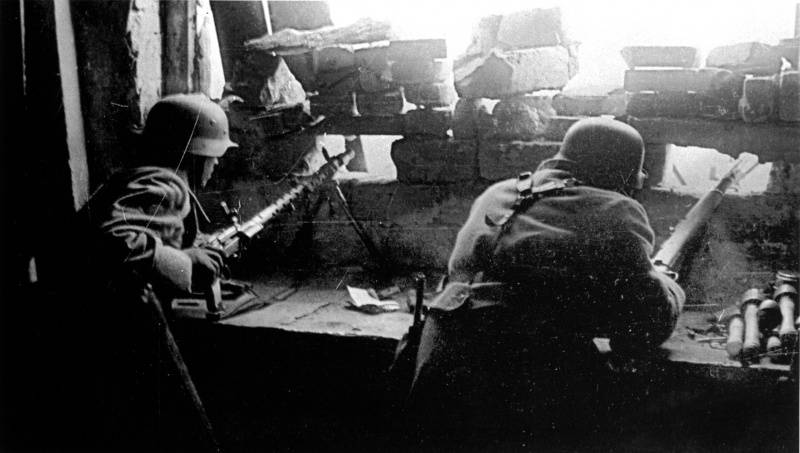
The position of the German machine-gun crew in one of the houses of Stalingrad
The notes of the intelligence department officer of the 8 Army Corps, Joachim Wieder, noted: “The offensive was preceded by thorough preparations by the Soviet command on a grand scale; Our higher headquarters were generally aware of the long process of concentration of enemy forces, although the deployment took place in a wooded area and under the cover of autumn fogs. Developing an offensive, superior tank and cavalry units of the Russians on the same day passed us at lightning speed from the north, and the next day from the east. Our whole army was taken in steel ticks. Three days later, in Kalach on the banks of the Don, the encirclement circle closed. Russian connections continuously increased.
Stunned, confused, we did not take our eyes off our staff cards — the thick red lines and arrows marked on them marked the direction of the numerous strikes of the enemy, his roundabout maneuvers, and areas of breakthroughs. With all our forebodings, we even in our thoughts did not allow the possibility of such a monstrous catastrophe! Staff schemes very soon found flesh and blood in the stories and reports of the direct participants in the events; from the north and from the west, to Peskovatka - just recently, a quiet steppe gully, where our headquarters were located, a stream of parts, which randomly retreated from the north and from the west, flowed over us. The fugitives brought bad news to us: the sudden appearance of Soviet 21 tanks in November in sleepy Kalach - our army rear - caused such an irrepressible panic there that even the strategically important bridge across the Don passed into the hands of the enemy. Soon, from the location of the 11 Army Corps, our neighbor to the left, whose divisions were in danger of striking from the rear, new crowds of ragged, dirty, utterly exhausted people poured into the Sandstone.
The prelude of the Russian offensive in the Kletskaya - Serafimovich sector was the many hours of artillery preparation - the destruction of fire from hundreds of guns plowed up the trenches of the Romanians. Turning then to the attack, the Russians overturned and defeated the Romanian units, whose positions were adjacent to our left flank. The entire Romanian army fell into a bloody meat grinder and actually ceased to exist. The Russian command very skillfully chose the direction of its strikes, which it inflicted not only from its Don bridgehead, but also from the area south of Stalingrad, from the bend of the Volga. These attacks hit the most vulnerable areas of our defense - the north-west and south-east, at the junction of our units with Romanian formations; The latter’s combat capability was limited because they did not have sufficient combat experience. They lacked heavy artillery and armor-piercing weapons. Essentially, we did not have any significant reserves in any sector; besides bad weather conditions doomed our inaction Aviation. Therefore, the powerful tank wedges of the Russians moved forward uncontrollably, and the numerous cavalry units, mobile and elusive, swirled around the bleeding wound of the breakthrough and, penetrating our rear, intensified confusion and panic. ”
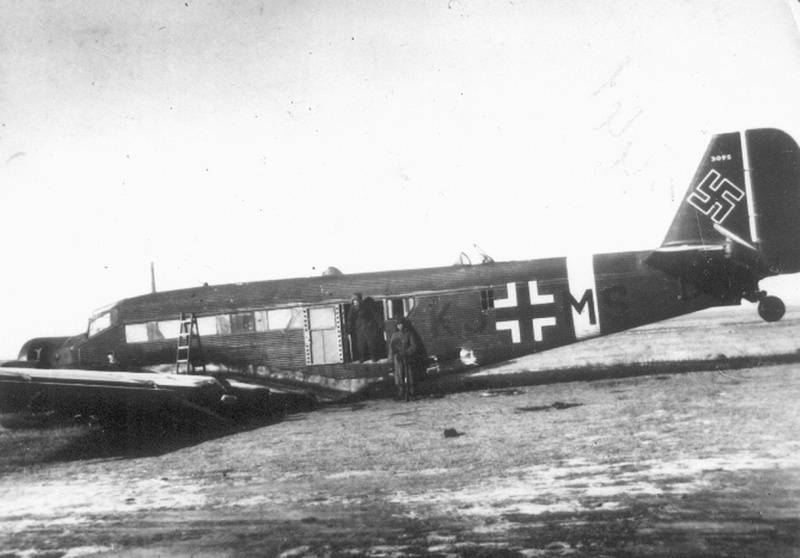
German transport aircraft Ju-52, boarded an emergency landing and captured by Soviet troops at Stalingrad
The transition to the offensive of the Stalingrad Front made an even stronger impression on the enemy. “We were experiencing anxious days,” wrote the participant in the battle, V. Adam. “A wide variety of rumors were being heard. No one knew where they came from. No one knew what was right in them. Did the enemy really cut off the highway route on the right bank of the Don to Chir station? Is it true that he reached the railway line from Morozovskaya to Don and that the 4-I tank army was defeated? What measures did the Main Command of the ground forces take to eliminate the threat of the army from the rear? Where is the 48 tank corps? Did he go on the offensive? What are the results?
Our nerves were strained to the extreme. Finally, on the evening of November 20, we learned something about the situation from our left neighbor, the 4th Panzer Army. The enemy broke through the German defenses from the south and advanced to the Don. The army group command allocated the 29 motorized division to close the gap, but the division could not withstand the onslaught of the Soviet troops, the 4 army corps and the 20 Romanian infantry division retreated and now fought south to front. Nothing was known about the other Romanian divisions in the south. According to the latest reports, the Soviet tanks approached directly to the command post of the 4 tank army. What was the turn of the case? A gaping breach on our left flank, and now also on the right ... The enemy was breaking through with increasing forces through our front, hacked in several places. The advance units of his advancing troops rapidly approached. And we did not have any reserves to prevent a deadly threat. It became known from the headquarters of the army group that the counterattack of the weak 48 tank corps of Lieutenant General Heim was immediately repulsed. Our air forces, which probably would have been able to alleviate the situation, could not conduct combat operations because of the snowstorm. Soviet tank units, advancing from the north, reaching the valley of the river Lisk, turned to the south-east, to Kalach. Neighboring units continued their advancement to the south, which posed a direct threat to the only supply communications - the railway going from the west through Morozovskaya to the Don and to the station of Chir. The path to the south, right up to the mouth of the Don by the Azov Sea, was almost open before the enemy ... ”
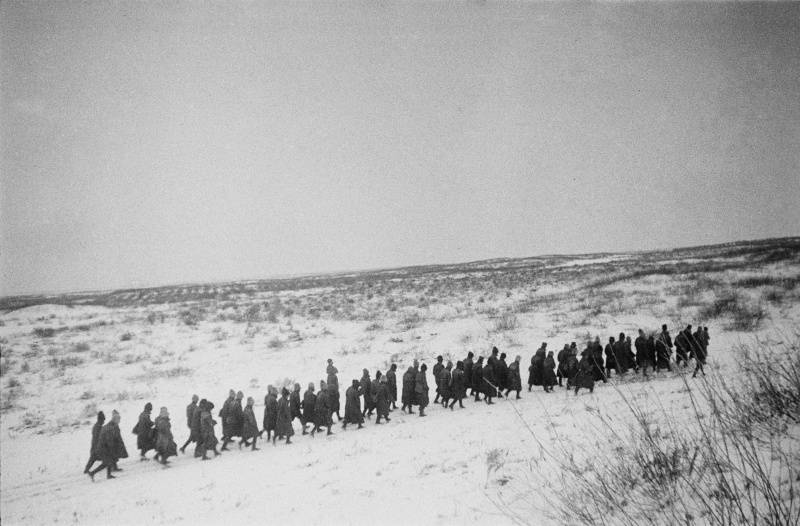
Column of Romanian prisoners of war taken prisoner in the area of the village of Raspopinskaya
21 November
The tank corps of the South-Western Front, followed by rifle and cavalry formations, continued to develop a successful offensive. The 26 tank corps, after refueling the vehicles, replenishing the ammunition and pulling up the lagged units, in 13 hours. continued movement. Tankers freed settlements Zotovsky, Kalmykov, the village of Horns, breaking the resistance of the enemy and smashing the rear of the German troops, leading battles with the 21-th army. On the night of November 21, Soviet tankers fought out in the Ostrov area, the Plesistovsky farm (35 km north-west Kalach) and continued the offensive.
The 1 Tank Corps had reached Bol by dawn on November 21. Donschinka, where he met a strong fire resistance. All attempts to take on the move Bol. Donschinka to success did not lead. The 5 tank infantry units advanced to the r. Cheer In pursuit of a retreating enemy, our troops occupied Gorbatovsky, cleared the enemy of Old Pronin, Varlamovsky. The enemy tried to organize a repulse at the turn of Bol. Donschinka, Korotkovsky, Zhirkovsky - against the center and left flank of the 5 tank army.
The 4 tank corps, operating on the left flank of the 21 army, moved from the Manoilin, Mayorovsky area. The Soviet tankers, having broken the resistance of the 14 Panzer Division, reached the Golubinsky area. 21-I Soviet army continued to destroy enemy defenses in the area Verkhne-Fomikhinsky, Raspopinsky. The 96-th, 63-th and 333-rifle divisions attacking the right flank of the army fought to encircle and destroy the Ropopin grouping - the 4-th and 5-th units of the Romanian army corps; 293-I infantry division by the end of the day advanced to the area of Verkhne-Buzinovka.
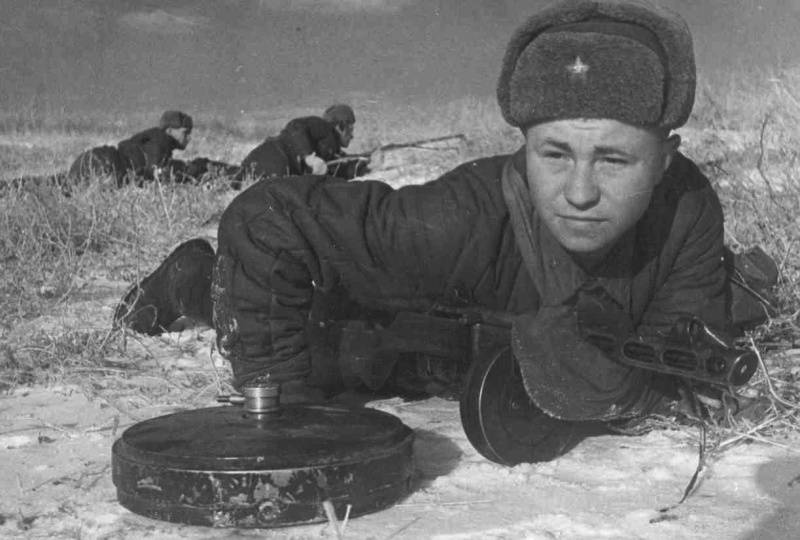
Soviet sappers clear the front line of defense from enemy mines in the Stalingrad area. In the foreground guard sergeant N. T. Zakharov pulls off the enemy anti-tank mine
Thus, the 6 th front of the German army continued to collapse. The gap on the left flank of Paulus’s army was rapidly increasing. The 11 Army Corps and the 14 Armored Division suffered heavy losses and were defeated in heavy defensive battles. 4-I tank army was dissected, its headquarters fled to the west. The Soviet tanks were in close proximity to the headquarters of the 6 of the German army in Golubinsky. They decided to transfer him to the Chir River, west of the Don, in the Lower Chirskaya. Paulus set up the commander of the 14 tank corps (he was removed from the front in order to close the gap) with General Huba: the 14, 16 and 24 tank divisions attacked Soviet troops advancing to the south to eliminate the threat of 6- th army from the rear.
Adam describes a figurative picture of the defeat and flight of the German and allied troops: “A terrible picture! Whipped up by the fear of Soviet tanks, trucks rushed to the west, cars and staff vehicles, motorcycles, horsemen, and horse-drawn vehicles, they drove at each other, stuck, overturned, blocked up the road. Between them they made their way, trampled, squeezed, pedestrians climbed. He who stumbled and fell to the ground could no longer stand up. He was trampled, moved, crushed. In a feverish desire to save their own lives, people left everything that hindered the hasty escape. They threw weapons and equipment, cars stood motionless on the road, fully loaded with ammunition, field kitchens and wagons, - because riding horses harnessed it was possible to quickly move forward. Wild chaos reigned in the Upper-Chir. The fugitives from the 4 tank army were joined by soldiers and officers from the 3 Romanian army and rear services of the 11 army corps moving from the north. All of them, covered in panic and dumbfounded, looked like each other. All fled to Nizhny Chirskaya. ”
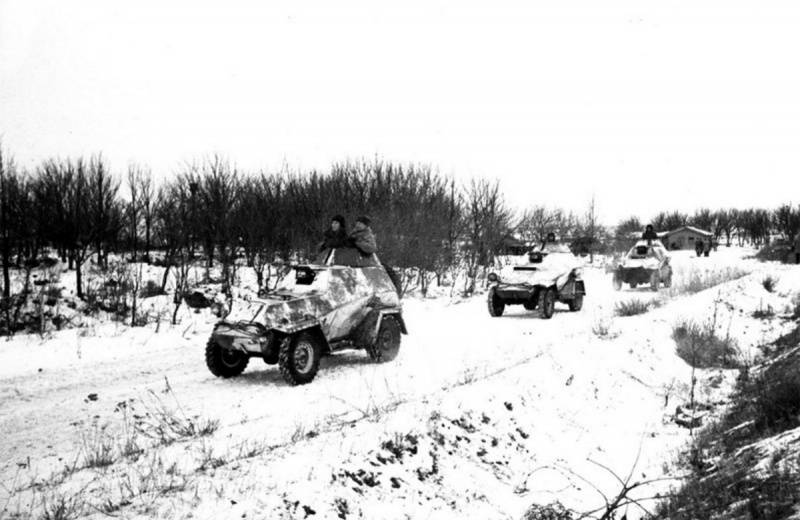
Column of Soviet armored vehicles BA-64 enters the firing line south of Stalingrad
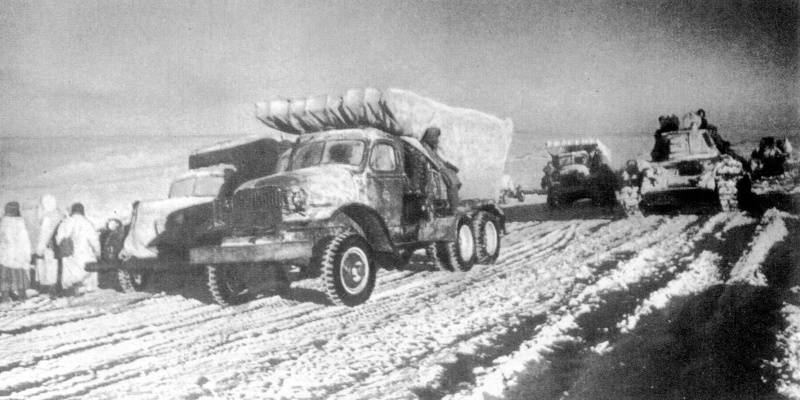
The Soviet forces advancing near Stalingrad: the Katyushas and the T-34 tanks
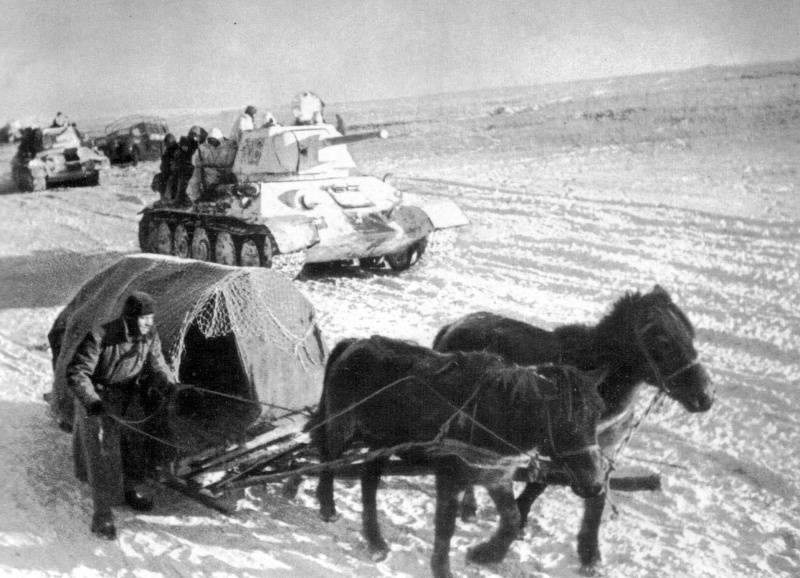
Horse-drawn carriage with food from a column of Soviet troops advancing with T-34 tanks
To be continued ...
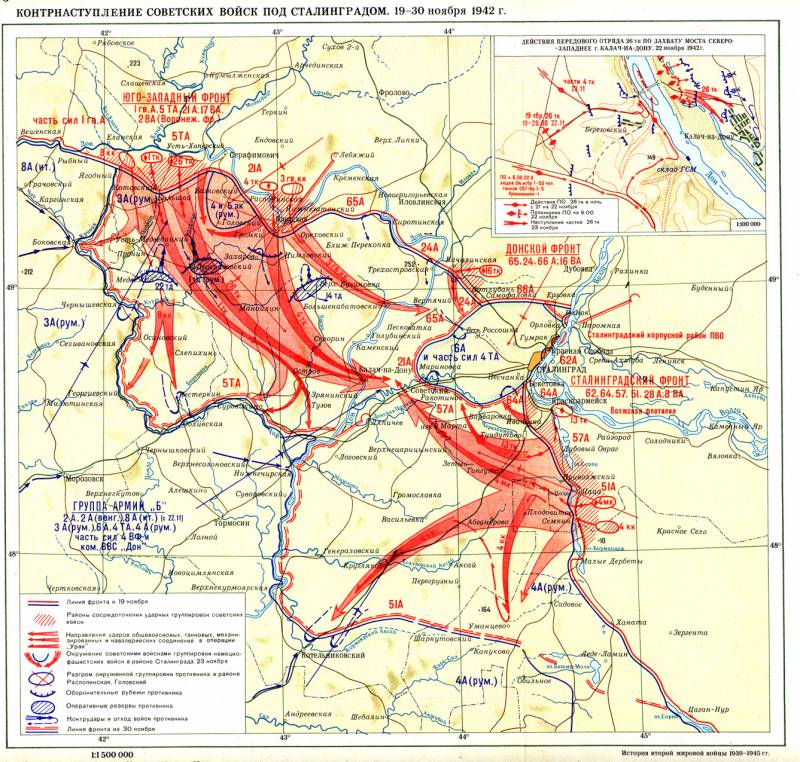
Information